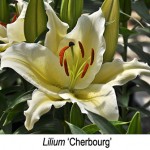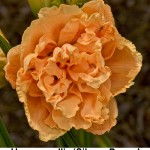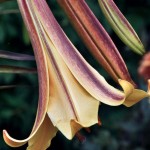When a gardener says, “She has some very nice lilies in her yard!”, the message received may be quite different depending on who hears it. Members of the lily family are among the most prized flowering plants for the home garden. Their throated, often fragrant blooms can add a lot to any landscape. But, when talking about the general category of “lilies”, the backyard gardener is usually talking about either the daylily or the hardy lily. Though related, they are quite different plants.
 Daylilies belong to the genus, Hemerocallis. The common name comes from the fact that individual flowers last just one day and then fade away. The good news is that a mature sized clump will develop dozens and dozens of buds and flower continuously with 5 or 6 blooms opening every day for a month or more. A few cultivars including the classic H. ‘Stella de Oro’ will have an initial flush of blooms and then follow with sporadic blooms throughout the rest of the season.
Daylilies belong to the genus, Hemerocallis. The common name comes from the fact that individual flowers last just one day and then fade away. The good news is that a mature sized clump will develop dozens and dozens of buds and flower continuously with 5 or 6 blooms opening every day for a month or more. A few cultivars including the classic H. ‘Stella de Oro’ will have an initial flush of blooms and then follow with sporadic blooms throughout the rest of the season.
 Daylilies form a clump made of tufts of grass-like foliage. They survive the winter as a swollen crown sheltered beneath the soil surface. Most varieties are extremely hardy and will thrive under widely varying conditions in the garden. I even know of one northern nursery who lift their daylilies from the ground as the last thing in the fall before snow falls. In some years, the snow interrupts the harvest and the bare root crowns of many daylilies are left on top of the ground. Next spring, when the snow melts, they just go out and pick the bare root plants up and they are as good as new.
Daylilies form a clump made of tufts of grass-like foliage. They survive the winter as a swollen crown sheltered beneath the soil surface. Most varieties are extremely hardy and will thrive under widely varying conditions in the garden. I even know of one northern nursery who lift their daylilies from the ground as the last thing in the fall before snow falls. In some years, the snow interrupts the harvest and the bare root crowns of many daylilies are left on top of the ground. Next spring, when the snow melts, they just go out and pick the bare root plants up and they are as good as new.
Daylilies are very easy to hybridize by either the professional or the hobbyist in the backyard. That is why there are over 50,000 named varieties registered with The American Hemerocallis Society. There are daylilies of a wide array of bloom seasons, flower sizes, heights and colors in all kinds of mixtures and patterns. Even with this vast array, however, there are no pure blue or pure white daylilies although plant breeders continue to search for the right genetic combination for these colors.
 Hardy lilies would include the Easter lily and the Tiger lily. The genus for these plants is Lillium and there are many different flower types available for the home garden. However, there are not nearly as many cultivars as there are with daylilies.
Hardy lilies would include the Easter lily and the Tiger lily. The genus for these plants is Lillium and there are many different flower types available for the home garden. However, there are not nearly as many cultivars as there are with daylilies.
Hardy lilies emerge from true bulbs and have a single, upright stem with pairs or clusters of leaves emerging along its length. Plant heights may vary from 12 inches to over 8 feet depending on the variety. Unlike daylilies, hardy lily flowers last many days before fading and several varieties are extremely fragrant. A single blossom may fill the vicinity with a wonderful scent.
There are about 9 different categories of hardy lilies used to describe their various forms. Briefly, these would include:
1. Asiatic Hybrids – Derived from species native to central and eastern Asia, these are plant of a medium size with upright and outward facing flowers.
2. Martagon Hybrids – These are one of the few shade tolerant lilies. The flowers are nodding, Turk’s cap type with the petals recurving backward. The ones that I grow do not have a very pleasant fragrance but they are wonderful in the hosta garden.
3. Candidum Hybrids – In this group are the hybrids of the species, Lilium candidum.
4. American Hybrids – These are clump forming perennials with a rhizomatous rootstock. They are generally tall growing types derived from the species Lilium pardalinum.
5. Longiflorum Hybrids – The species Lilium longiflorum form the basis of these cultivated lilies. Many of them are used for cut greenhouse flowers and are less commonly grown in the garden.
6. Trumpet Lilies – As the name implies, plants in this category have tubular, trumpet shaped flowers which face upwards and are often extremely fragrant. It includes the Aurelian hybrids along with hybrid plants from the Asiatic group.
7. Oriental Hybrids – This is the home of the “Stargazer” type of lilies so named because their blooms tend to face upwards. Hybrids of the species Lilium auratum and L. speciosum along with several species from Japan make up this group. The plants tend to be tall, have large and fragrant flowers.
 8. Other Hybrids – Includes all other garden hybrids not included in the first seven.
8. Other Hybrids – Includes all other garden hybrids not included in the first seven.
9. Species – These are all the naturally occurring species that are not included above.



